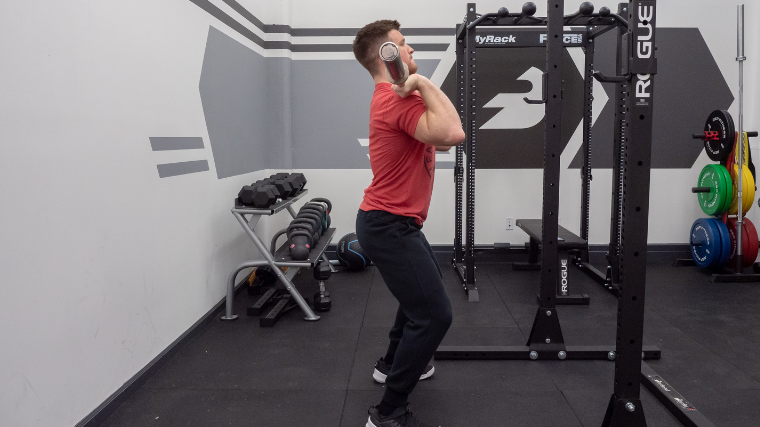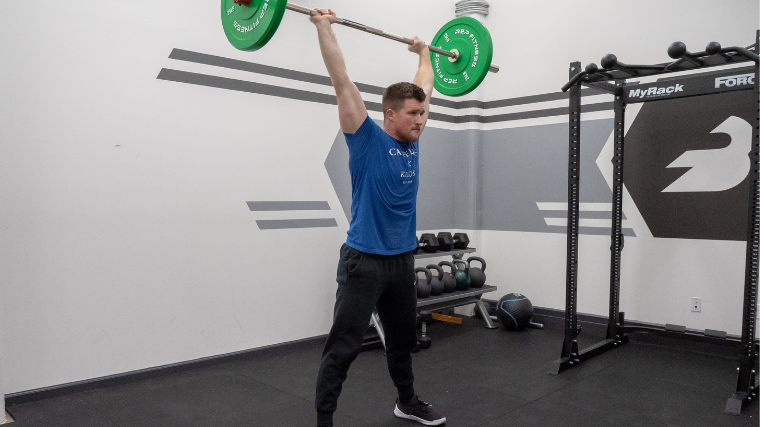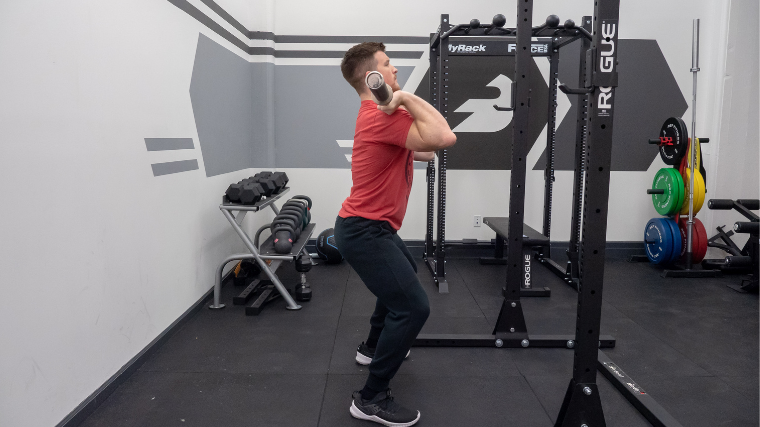Perfect the Push Press for Muscle and Strength Gains
If you want to start lifting heavier weights overhead, look no further than the push press. The push press is a variation of the overhead press that brings the lower body to the party to help take your shoulder training up a notch.
Yes, you heard that right — your leg days can pay off in a new way. By utilizing your quad and glute gains alongside your upper body to drive the bar overhead to a smooth lockout, you can realize new gains in both strength and size.

The push press is the ultimate training tool for improving timing and power utilization in overhead movements, Olympic lifting, and general performance training.
- How to Do the Push Press
- Push Press Sets and Reps
- Common Push Press Mistakes
- Push Press Variations
- Push Press Alternatives
- Muscles Worked by the Push Press
- Benefits of the Push Press
- Who Should Do the Push Press
- Frequently Asked Questions
How to Do the Push Press
The push press is an overhead press variant that uses the legs to create power. To begin the lift, the legs bend to an athletic dip position, followed by a speedy extension of the body to drive the weight overhead. A successful completion of the lift ends with the bar overhead, with both the arms and legs straight.
Step 1 — Setting Up
To set up the lift, bring the barbell to the shoulders in front as you would for a barbell overhead press. Find a relaxed, open grip on the bar in both hands to allow for the elbows to come through. Keep your torso tall and your upper back engaged. The feet should be hip-width apart, and the legs should be straight.
Coach’s Tip: Your vision should be fixed at eye level, straight ahead. The center of gravity should be mid foot, centered over the ankle bones.
Step 2 — Dip Your Legs
Once set, dip the legs to a quarter squat position. The hips should travel straight downward a few inches as the knees point out over the toes. Perform the dip with the chest up tall. The dip is incorporated in the beginning of the movement to get set in the correct position for producing leg power.
Coach’s Tip: In the dip, the elbows should not drop downward at all.
Step 3 — Drive and Finish
After the dip, explosively change direction and use your legs to impart force into the barbell. Your ankles, knees, and hips should extend fully as the bar flies off of the shoulders. Tilt your head back so the barbell can move vertically. As you press the barbell overhead, transition from a loose grip to a firm hold.
Coach’s Tip: When driving the bar overhead, avoid pressing the weight out in front. Make sure to drive straight upward to maintain your balance.
Step 4 — Catch the Bar
A re-racking motion of the bar to the shoulders may be necessary to connect repetitions of the push press. As the bar returns to the shoulders from overhead, prepare to receive the bar with a bend in the legs. When the shoulders contact the bar, the legs should bend to a quarter squat position, then return back to standing to safely reset for the next repetition.
Coach’s Tip: Do not start bending the knees in the re-rack until the weight touches the shoulders. Once the bar makes contact, dip your legs fluidly to absorb the impact of the bar.
Push Press Sets and Reps
As an accessory movement for Olympic lifting, the push press isn’t the most versatile exercise out there. You can, however, use it for different purposes within (or tangential) to the sport. Here are a few different ways to program the push press.
- To Learn Technique: Start with 4 to 6 sets of up to 3 reps with a light weight.
- For Jerk Development: Work between 5 and 7 sets of 2 or 3 reps with a moderate weight.
- As a Conditioning Tool: Perform as many as 10 total sets with limited rest and roughly 5 reps per set.
Common Push Press Mistakes
It’s more brutish than its elegant, competition-approved cousin (the jerk), but the push press still takes finesse to perform well. The difference between making your technique razor-sharp and simply trying hard can mean many kilograms lost over time.
Here are a few potential mistakes to avoid while you practice the push press.
Pressing Forward
When you’re learning to push press (or jerk), you might find yourself in the habit of pressing the bar up and out, away from your body. Not only will this seriously limit the amount of weight you can use, it’s also a habit that can be quite hard to correct.
Make sure you’re moving your head backward so the bar can travel freely in a vertical line.
Using Your Arms Early
The push press is technically a press, but the prime movers of the exercise are your quads and glutes. As such, it is imperative that you initiate the movement with your legs and not your arms. The dip and drive phase of the push press should impart enough force into the bar that it flies off your shoulders and passes your head before you have to engage your arms.
Standing Too Narrow
The push press is not a military press, where you stand with your feet placed tightly alongside each other. The explosive nature of the push press demands a wide and stable base of support.
Keep your feet at least pelvis-width apart — you can even experiment with a wider, more athletic stance to see if it works better for you.
Push Press Variations
Because the core movement pattern of the push press is highly versatile, there are plenty of variations available to spice up your training. Depending on your training situation, you may need to exchange the default lift for one of its cousins. Try out these variations of the push press in your routine to better supplement your specific training goals.
Kettlebell Push Press
A standard push press can be performed while holding one or two kettlebells in the front rack position. While this lacks the loadability and maximal strength development of the barbell version, using kettlebells provides a different form of stimulation and can be useful if on a deload or working around an injury.
Snatch Grip Push Press
In the snatch grip push press, the barbell rests on the back in the start position with a wide snatch grip. The dip and drive motion, however, is identical to the traditional push press. This variation of the push press applies to movements such as the snatch, overhead squat, or snatch balance by refining overhead stability with the relevant grip.
Paused Push Press
In the paused variation of the push press, the athlete halts at the bottom of the dip. It is more difficult to produce power in the drive after a pause because there is no momentum acting on the barbell, and no elastic reflex in the legs or hips.
By pausing at the point where you would normally change direction, you’re forced to spend more time developing strength in the proper technical positions, while also learning to create absolute power from a static start.
Push Press Alternatives
The push press is a difficult exercise to master. Luckily, there are many alternative exercises that can be used to help learn the movement pattern. These exercises can either be used in lieu of the push press, or as complementary exercises to the push press itself.
Strict Press
The strict press is an overhead press that involves only upper body strength. The bar is pressed from shoulders to overhead without any assistance from the glutes, quads, or calves.
[Related: The Ten Commandments of the Overhead Press]
This variation can be beneficial for individuals who want to improve their overhead strength by isolating the upper body. It can also be practiced when first introducing the push press as a digestible primer for moving a barbell overhead.
Thruster
The thruster combines a standard push press with the leg stimulation of a front squat to create a full-body stimulus. By performing a squat with the barbell and driving directly into the push press, you can get some additional leg training in and enhance total body coordination all at once.
Push Jerk
The push jerk is a variation of an overhead press that is similar to the push press. The lift involves a dip and drive, but rather than a full extension overhead to straight legs, the legs return to a high squat in the catch. It is a powerful, abrupt movement that allows you to tangle with much heavier weights and level up your balance and coordination as well.
Muscles Worked by the Push Press
The push press is an advanced version of the overhead press that requires total body contribution to be successful. Incorporation of the lower body into the lift allows for high amounts of power to be produced against heavy loads. A chain reaction quickly transfers the power from the lower body to the arms and shoulders, where technical precision and strong muscular engagement are paramount.
Quadriceps
The quadriceps facilitate the dipping motion of the legs, then generate upward speed on the bar with forceful contraction. As one of the strongest muscles in the body, the quads do a lot of the proverbial — and literal — legwork in each repetition of the push press.
Glutes
The glutes generate a ton of power towards the end of the drive phase. As the legs dip and then reverse, the glutes powerfully contract to create extra vertical force on the bar. The glutes also come strongly into play to control the rate of the dip and drive.
Shoulders
The shoulders are responsible for finishing the lift. After the leg drive is complete, the load must quickly transfer to the arms and shoulders, where the upward trajectory of the barbell continues to full extension. Without strong shoulders and triceps, a successful push press simply isn’t possible.
Core
A strong core is crucial for a successful push press, as the upright position of the torso underneath the weight is achieved by three-dimensional bracing. If the core lapses in tension at any time, the lift will most likely lose its power and be pressed out in front, rather than straight overhead.
Benefits of the Push Press
The push press is a productive training tool. The lift allows for tons of power and speed, but it can only be achieved through dedication to the proper technique. Improvements in push press execution translate widely to other overhead movements, as well as to functional activities like CrossFit or traditional sports.
Increased Acceleration
With practice, the ability to accelerate your movement under load can be improved. Incorporating acceleration to a standard press allows for an increase in both total weight used and power generated that goes beyond the limits of what your shoulders and arms can produce on their own. Acceleration ability obtained through practice of the push press often leads to gains in other areas of fitness.
Leg Strength Development
High amounts of power can be generated in the push press through force production from the legs. Repeated practice of the push press can improve the lifter’s ability to fully utilize the tremendous power of their lower body. As leg strength in the push press develops, not only will power output increase, but it will also be used more efficiently.
Improved Weightlifting Technique
The push press is often used by Olympic lifters as an accessory exercise for the jerk. The dip and drive motion of the push press exactly mirrors the loading phase of the power or split jerk. The push press is a unique way to reinforce good weightlifting technique without having to rely too heavily on the competition lift itself.
Overhead Stability
When compared to strict variations of overhead pressing, the push press allows for much more weight to be lifted overhead — this naturally requires more significant shoulder strength and stability. Practicing the push press over time will result in improved ability to support heavier loads overhead with more confidence and control.
Who Should Do the Push Press
Push presses should be performed by anyone looking to improve their overhead mobility and total body strength. It’s a purposeful exercise that can be done by individuals looking to make improvements in their weightlifting technique or general resistance training performance.
Olympic Weightlifters
The push press is a supplementary exercise for the jerk in Olympic weightlifting. Since the powerful dipping motion of the push press exactly mirrors that of the jerk, repetitions of the push press are highly valuable as a training tool. By practicing a smooth, full extension in the push press, those interested in Olympic lifting can refine their timing and rhythm.
Traditional Athletes
Many athletes have goals of maximizing power output in their sport through general strength training. Power is generated by moving weight with force and intent at a high speeds.
Athletes who practice push presses develop an improved ability to produce power through their legs, which often transfers directly onto the field for improved performance.
CrossFitters
CrossFit training includes a variety of different strength movements involving total body power, such as the thruster, burpee, or sled push. The Olympic lifts and their variations are also commonly done both in practice and competition. The strength and technique gains acquired from push pressing are likely to have a lot of carryover to many aspects of CrossFit.
Wrapping Up
Now that you have all the information you need on the push press, it’s time to get to work. The best way to get value out of a movement like the push press is to practice the technique extensively.
Consistent practice of the push press will not only increase your power output, but will help you understand how to use your newfound power more methodically.
The benefits of the push press do not stop at just the exercise itself. Once you achieve mastery of the movement, there is nearly endless potential for what you can accomplish in the gym. Producing power with the barbell is a valuable skill, and the push press is one of the best ways to get your game up.
FAQs
The push press is a complex movement. Even after everything has been laid out, you may still be missing a few important details. See below for further information on what you can do if something still does not feel right.
What if I’m limited by my front rack mobility?
If you find that you’re limited in your front rack mobility, just know that you’re not alone. It’s one of the most common limitations that individuals face when practicing weightlifting. With the right mobility exercises and consistent practice of the front rack position over time, the front rack position can be significantly improved. If you’re struggling to fully grip the barbell, it is possible that your lats or another muscle in your upper back are tight or restrictive.
What if the push press is painful on my wrists?
Early practice of push press can warrant high pressure on the wrists. In this case, it’s best to keep the weight load low enough where repetitions can be practiced with no pain. If the stress on the wrists become too intense, try changing the medium to a dumbbell or medicine ball push press or adding a pair of wrist wraps.
I’m having trouble pressing my arms fully straight overhead. What can I do to improve this?
Completion of the push press ends with straight arms overhead. However, full extension of the elbows is not always as easy as it sounds. Shoulder mobility often limits overhead extension, so make sure to open the shoulders through a good warm-up. Additionally, underdeveloped triceps can contribute to a weak lockout. Tricep training can have a beneficial influence on push press extension.
{"@context":"https://schema.org","@type":"FAQPage","mainEntity":[{"@type":"Question","name":"What if Iu2019m limited by my front rack mobility?","acceptedAnswer":{"@type":"Answer","text":"
If you find that youu2019re limited in your front rack mobility, just know that youu2019re not alone. Itu2019s one of the most common limitations that individuals face when practicing weightlifting. With the right mobility exercises and consistent practice of the front rack position over time, the front rack position can be significantly improved. If you’re struggling to fully grip the barbell, it is possible that your lats or another muscle in your upper back are tight or restrictive.
"}},{"@type":"Question","name":"What if the push press is painful on my wrists?","acceptedAnswer":{"@type":"Answer","text":"
Early practice of push press can warrant high pressure on the wrists. In this case, itu2019s best to keep the weight load low enough where repetitions can be practiced with no pain. If the stress on the wrists become too intense, try changing the medium to a dumbbell or medicine ball push press or adding a pair of wrist wraps.
"}},{"@type":"Question","name":"Iu2019m having trouble pressing my arms fully straight overhead. What can I do to improve this?","acceptedAnswer":{"@type":"Answer","text":"
Completion of the push press ends with straight arms overhead. However, full extension of the elbows is not always as easy as it sounds. Shoulder mobility often limits overhead extension, so make sure to open the shoulders through a good warm-up. Additionally, underdeveloped triceps can contribute to a weak lockout. Tricep training can have a beneficial influence on push press extension.
"}}]}
Featured Image: Pressmaster / Shutterstock
Deja una respuesta





►Te puede interesar...